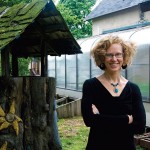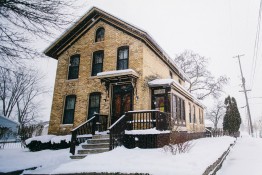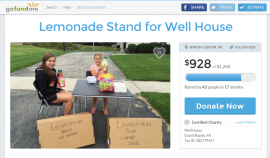
There seems to be a common thread throughout the cause of actively growing communities. Investing in others through real estate rehab increases personal profits and growing communities at large. Vacant homes and empty lives seem to increase simultaneously. One nonprofit group, Well House, has determined to make vacant homes effectively solve the 30-year problem of homelessness. Real estate rehab has long been recognized as a bright spot to neighborhoods and communities at large. But, why would we want to use real estate investment to expand a pocket other than our own? Because these investments, too, increase simultaneously. As we enrich everything from curb appeal, the inside of homes, to the people’s lives who inhabit these homes, we increase the value of the surrounding landscape. We also enrich many lives, including our own. Well House achieves this in a fascinating way.
Nineteen To One: Vacant Homes To Homeless People?!
I was raised to believe that I could have anything if I wanted it badly enough. During my ever widening desire to understand what differentiates the success and failures of individuals, I continue to learn more than I had once anticipated about the plight of the homeless and how creatively helping them seems to have an unending possibility for growing communities and increasing personal investments. In 2013, there were 1900 empty units and 752 homeless people in Kent County. Shockingly, that equates to 19 homes for every one homeless person. This staggering realization triggered Tami Vandenberg, Enreprenuer and Executive Director of Well House, to create the "19:1" campaign. To raise  awareness, discussion, and passion-induced efforts, Well House staff led a nighttime walk with community members and public officials. They walked through neighborhoods equipped only with a flashlight to illuminate their path. The group stopped at each vacant home, looked in the windows, and paused. They repeated this at each vacant home much like you would visiting a grave site. I wonder how many of the 329 homeless children they encountered cowered in sleeping bags under trees, or in warming centers along their journey.
awareness, discussion, and passion-induced efforts, Well House staff led a nighttime walk with community members and public officials. They walked through neighborhoods equipped only with a flashlight to illuminate their path. The group stopped at each vacant home, looked in the windows, and paused. They repeated this at each vacant home much like you would visiting a grave site. I wonder how many of the 329 homeless children they encountered cowered in sleeping bags under trees, or in warming centers along their journey.
“As awareness builds through the campaign, the idea is to implement a shared housing model in vacant housing units.” ~Tami Vandenberg
Well House's First Real Estate Rehab
The Well House Founder is no stranger to humble roots. Frustrated and unable to hold a job, Marian Clements found refuge and an education within a Quaker community. She said it was being empowered by their positive attitudes that inspired her to climb out of her own negative ditch. In 1977, she was determined to stand on her won two feet, and help others to achieve the same. So, she purchased a hundred-year-old home at the intersection of Cass and Pleasant  Street in Grand Rapids, MI for $350 and named it Well House. That home was the start to the 12 homes that Well House now owns. It housed the first of the 91 lives that Well House has since brought in off the streets. The increased awareness of others’ plight, along with the passion of the growing communities at large, fueled the purchase and renovation of vacant buildings. Thus, closing the gap between vacant homes and the homeless people who so desperately needed them. Just as we spoke of in reference to the Pescadero Lofts, Well House has determined to help people be permanently housed. Residents are provided treatment options for various recovery needs while integrating back into the community. Residents may stay short term, or for many years, depending on their individual circumstance and needs. Numerous opportunities have been recognized or created within the Well House communities.
Street in Grand Rapids, MI for $350 and named it Well House. That home was the start to the 12 homes that Well House now owns. It housed the first of the 91 lives that Well House has since brought in off the streets. The increased awareness of others’ plight, along with the passion of the growing communities at large, fueled the purchase and renovation of vacant buildings. Thus, closing the gap between vacant homes and the homeless people who so desperately needed them. Just as we spoke of in reference to the Pescadero Lofts, Well House has determined to help people be permanently housed. Residents are provided treatment options for various recovery needs while integrating back into the community. Residents may stay short term, or for many years, depending on their individual circumstance and needs. Numerous opportunities have been recognized or created within the Well House communities.
Related: The Ripple Effect of Real Estate Rehab
What do rehabbing lives have to do with me?
Thankfully, many of us will never know what it is like to be homeless. How does homelessness affect the “rest of us”? Sam Tsemberis,
 Elizabeth Olsen and Jennifer Anniston with homeless "Radioman."
Elizabeth Olsen and Jennifer Anniston with homeless "Radioman."professor of Psychiatry at New York University answered this question well. “We have to shut down part of ourselves to tolerate the pain of seeing homeless people as we walk by. We are together in a shared suffering that can be alleviated.” This also partly answers the commonly asked questions of How does solving homelessness benefit those who aren’t homeless? ”With the multitude of mortgage foreclosures a few years ago, the gap between homeless and non-homeless populations diverged. There was very little keeping those of us who are not homeless from becoming those who are.
Concerns of the darker side of what creates homelessness can be rectified as well. The Housing First model adopted by Elvis Summers and the St. Brighid project at the Pescadero Lofts has recognized that untreated substance abuse and mental illness are devastating conditions that most commonly lead to homelessness. We are also becoming increasingly aware that these two issues are too difficult to solve while living on the streets; hence, the reason for providing housing first.
Related: Growing Communities of 2015 Expand in 2016
Children's Lemonade Stand Becomes A Real Estate Crowdfunding Campaign
To talk about turning lemons into lemonade: Three school-age girls on a walk were so affected by passing a homeless person that they  decided to raise money for him with a lemonade stand. In 2013, one in 30 (two and a half million) American children had experienced homelessness. We are fortunate that these three youngsters (from second to forth grade) were not among them. Reese, Aubrey and Alexa’s lemonade stand raised $127, and that was just the beginning. Well House is also fortunate that one of their Mothers used crowdfunding to further the children’s idea and efforts. Those who didn’t happen by the lemonade stand could still contribute to the girls' efforts by donating to the Lemonade Stand For Well House gofundme campaign. This campaign turned into a real estate crowdfunding campaign, as the funds totaling $777.00 were donated to the Well House renovation projects. Last year, they did it again and raised $928. A lemonade stand and became a peer-to-peer real estate crowdfunding campaign that helped turned yet more vacant homes into homes for the homeless. Nice job!
decided to raise money for him with a lemonade stand. In 2013, one in 30 (two and a half million) American children had experienced homelessness. We are fortunate that these three youngsters (from second to forth grade) were not among them. Reese, Aubrey and Alexa’s lemonade stand raised $127, and that was just the beginning. Well House is also fortunate that one of their Mothers used crowdfunding to further the children’s idea and efforts. Those who didn’t happen by the lemonade stand could still contribute to the girls' efforts by donating to the Lemonade Stand For Well House gofundme campaign. This campaign turned into a real estate crowdfunding campaign, as the funds totaling $777.00 were donated to the Well House renovation projects. Last year, they did it again and raised $928. A lemonade stand and became a peer-to-peer real estate crowdfunding campaign that helped turned yet more vacant homes into homes for the homeless. Nice job!
Well House, a non-profit organization, receives their funding through such creative crowdfunding campaigns as the one these small girls inspired. The vacant homes that are purchased and renovated by Well House are also possible due to grants from the W.K. Kellogg Foundation and The Grand Rapids Community Foundation, as well as from private donations.
Every aspect of what this group has accomplished by Well House in Grand Rapids, MI can be emulated in other areas. This fact is inspiring on its own. Just as we did with the Tiny House Huge Purpose project in Los Angeles, and the Pescadero Lofts two and a half hours away, Patch of Land's Growing Communities continues to connect these groups to each other to increase and spread the wealth. Let’s see what happens next.
How can other growing communities inspire your own? In what ways can real estate crowdfunding help your cause? Leave a comment and let us know what you think.




Laurie commented January 27, 2016
I never cease to be amazed and heartened by all the organizations highlighted so well by this author. The fact that elementary school girls were so moved is tremendous - kudos to them and the Mom who jumped in to help.